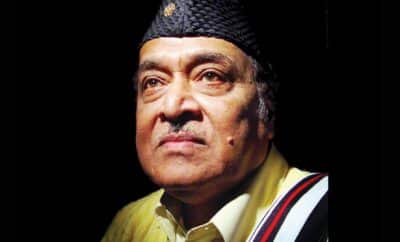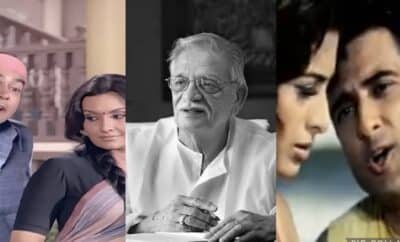Press Release
There is a Lata beyond what is played on the Radio
When a book pertaining to music begins with a chapter titled – Who is Lata Mangeshkar, you know it is not basically for Indian readers. There seldom might be an Indian who doesn’t know Lata Mangeshkar. The authors then share a small chapter about the Gramophone companies and LP records in India. Why? Because the book is based on the LP record, Lata Mangeshkar – My Favourites Volume 2. They also have a separate chapter describing the music terms and sources used in the book. The chapter enlists and explains terms like Thaat, Raag, Murki, Harkat, Taan or Asthayi/Mukhra, Antara, Sanchari, Abhog etc. When the book ‘gets started’, it enlists the music directors and lyricists whose work form part of the album. It says – to help the readers get acquainted with their names. All these initial chapters by the authors suggest that the book is really not meant for the Indian readers and yet it is absolutely meant for Indian readers too.
Bloomsbury Publishing, a British company, brings out this book under its 33 ⅓ series. It is a series of short books about popular music, focusing on individual albums by artists all over the world. It is the second book commissioned by South East Asia and first by the Indian Writers. The book is a unique perspective on Hindi film music history through the personal selections of one of India’s most iconic singers. Anirudha Bhattacharjee and Dr. Chandrashekhar Rao, two well known names in the literary field (music), give readers a panoramic view of the fifty songs chosen by Lata Mangeshkar for the album. From the vintage – Anil Biswas and Ghulam Haider to unconventional Salil Chowdhury and Jaidev to popular R D Burman and Laxmikant Pyarelal, their in-depth knowledge of the subject and the analytical dissertation, makes it a must-read for every music lover.
TheSongPedia interviewed the authors to know more about the book and their journey.
TheSongPedia in conversation with Anirudha Bhattacharjee (AB) and Dr. Chandrashekhar Rao (CR).
You can buy the book here –
Lata Mangeshkar: My Favourites, Vol. 2
1. Dr. Rao, since you lived away from the country for several years – how were you able to keep in touch with the subject (music) when there was no internet? What difficulties did you face? With internet and social media nowadays, it is easy to access groups and blogs of your choice to keep up with your passion and interests (music),
CR – Being a keen musician and quizzer and having been an ardent listener of programmes on Sri Lanka Broadcasting Corporation (the erstwhile Radio Ceylon), I had a considerable amount of background detail relating to film songs in my head right from an early age.
During the three and a half decades I worked in Dubai from 1980 onwards, although my primary job was as a doctor, I also wrote freelance for a local English newspaper. Thus, wearing a ‘Press’ tag, I managed to bag interviews with many luminaries of Hindi film music who visited Dubai for their concerts and stage shows, and some of them subsequently became close friends as well.
The post-internet era opened a floodgate of information, granting access to friendships with like-minded music lovers all over the world, and songs on YouTube uploaded by generous music collectors.
2. What prompted you to write a book on this topic?
CR – I will defer to senior co-author Aniruddha on this one.
AB-In early 2022, I received an email from Natalie, our editor, inviting me to write a volume for the 33⅓ series—on an album by one of the Burmans. Guide and Amar Prem were obvious choices. But then Lata Mangeshkar passed away. And I thought—why not Lata herself? Not just the voice of the Burmans, but of Indian cinema.
That’s how this book came to be. Sometimes, the subject finds you.
3. What resources did you find most helpful and interesting in your research for the book?
CR – In addition to re-listening to each song with an attentive ear, I tried to talk with people directly involved with the creation of each song (unfortunately very few survive today) or their contemporaries, in addition to finding archival information from reliable books, old magazine interviews and articles.
AB- Best part was revisiting the songs and sometimes the films. I consulted Snehasish Chatterjee’s Lata Geet Kosh for data and correctness of the names (some on the HMV album have issues and the same have been mentioned in our book). There are multiple books on Lata, from Raju Bharatan’s critical take in 1994-95, Harish Bhimani’s personal stories, Dr. Mandar Bichu’s excellent compilation about her work with most composers, Nasreen Munni Kabir’s documentary on Lata, Yatindra Mishra’s Lata Sur Gatha which is a fine repository of Q&A sessions. We checked out a few more books too. And as Doc Rao mentioned, we tried to touch base with people who would know. This helped especially in the case of non-films songs, and you will find we have mentioned about the interviews conducted with them. Tracking them down wasn’t easy, but the insights they shared really added depth — and yes, we’ve mentioned those interviews in the book. I suggest the reader to check out the book to find out.
4. Can you share a song or a chapter discussed in the book that you enjoyed or are happy to share with the readers?
CR – I would pick Khayyam’s composition Baharon, mera jeevan bhi sawaro from Aakhri Khat – not only is Lata Mangeshkar at her enchanting best here, but the song is also a very early example of classical instrumentalists Rais Khan (sitar), Hariprasad Chaurasia (flute) and Shivkumar Sharma (santoor) playing in a film song.
AB- Most of the tracks in the book are among my favourites too. But if I had to choose — say, at gunpoint — I’d pick Baahon Mein Chale Aao.
There’s a personal story behind it as well, which I’m hoping to explore in a book currently in the pipeline.
5. What do you believe is the most interesting learning for the readers?
CR – In addition to providing whatever insight we could into technical aspects of the songs (such as ragas or chord structures) we have tried to narrate any interesting back stories or trivia relating to them. Hopefully the reader (turned listener) can then view or revisit a song in a new light.
AB- That there is a Lata beyond what is played on the radio maybe? Especially for the current generation I mean…
6. How did you approach analyzing the songs?
CR – We tried to cover all aspects of a song – its lyrical value, its tune and raga, the ornamentation of its arrangement, and any other information that would ground it in context of its era or its situation in the movie.
AB- Ditto, as Doc Rao mentions
7. What part was challenging for you while writing?
CR – There can never be thought block when it comes to writing about Lata Mangeshkar! On the contrary, given Bloomsbury’s word limit and the fact that we had been assigned (by association) the daunting task of introducing Lata to a Western readership, the challenge was in applying restraint in not waxing eloquent, and not penning a hagiography.
AB – Just as Doc Rao mentions. The main challenge was to appreciate what not to write as space was a major constraint and the target audience new. 50 songs and only 30000 words? I would have bargained for 100000 words if I had my way!
8. What impact do you hope your book will have on readers?
CR – If we can leave the reader with even a small degree of insight into the magic and enchantment that Lata Mangeshkar has cast over the Indian subcontinent, it will be a job well done. I would urge a reader to seek out and listen to the songs analysed in the book, for greater appreciation of the compositions and (hopefully) our analysis of the same.
AB – Ditto
9. Second book commissioned by South East Asia and first by the Indian Writers. How does that feel?
CR – Euphoric!
AB- Very happy, as this is my first international publication
10. The editor being an American, any challenges you faced music wise?
CR – As expected by a prominent publishing house like Bloomsbury we had several exchanges and submissions before the final copy was approved. The challenges, if any, were only edits related – none as far as the music was concerned.
AB – Natalie teaches Indian music, especially percussion at Stony Brook University, and knows the basics of our music well. So, there was no challenge at all. She read the manuscript and wrote back –
Dear Anirudha and Chandra Shekhar,
I’ve read through the manuscript, and it looks very, very good.
11. What role does music play in your life besides writing about it?
CR – A lot! I am a keen accordion player and listen to many types of music from the world over. Also being a keen quizzer, I love to seek out and mentally file away interesting bit of trivia relating to songs, composers, singers, etc. Music is ingrained in my DNA.
AB- I sing, and when in mood, 24 hours a day. I see a lot of films, but mainly Holly and Brit. I used to see a lot of Hindi films when in school, so the songs have remained with me. I used to play the guitar; might pick it up once more. Like Doc Rao, I also quiz, but the frequency has come down in recent years as quizzes are more about current affairs and wordplay and less funda. Something that does not interest me.
12. How do you balance your personal interests/preferences with the need for neutrality when writing?
CR – This was indeed a tough nut to crack, particularly with this book. All the songs were already Lata Mangeshkar’s own favourites and therefore beyond question, and my own favourites among Lata songs would comprise a completely different list. I also had to dissociate (as best as I could, this too being a tough task) from the powerful charisma and musical influence Lata has among listenership in the Indian subcontinent and try and present her to a Western readership as best as I could. Anirudhha and I have done a decent job of it, I think.
AB- My friend Juhi Adesara, who is also the grand daughter of famed sound recordist Ishan Ghosh calls me the most neutral writer she has read. As with my previous books, I’ve stayed neutral throughout. Personal preferences aside, I’ve never felt the need to vilify any song, singer, or composer.
My approach has always been to rely on data and analysis to build a case. If I don’t like something, I usually choose not to write about it — unless it’s essential. And if it is, I make sure to back it up with context and evidence.
That’s the only way I know how to write.




Pratik Majumdar
July 26, 2025 at 8:34 pm
What a wonderful exchange of thoughtful, insightful questions and observant, indepth, pertinent answers. Looking forward to read this book.